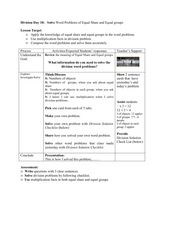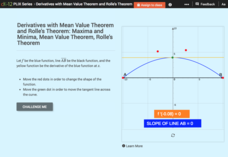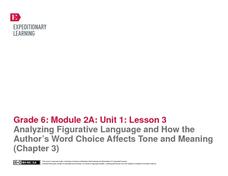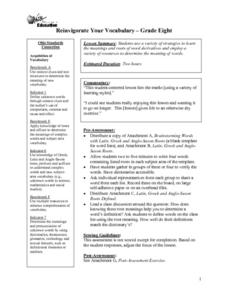Curated OER
Choosing the Right Word for the Sentence
Learners select the best word (from four choices) to complete eight sentences. They read a complete sentence and choose the best word to complete subsequent sentences using context as their guide. Theme of the sheet is making things,...
Curated OER
Guide Word Sentences
Learners write sentences using dictionary guide words, putting two guide words from the same page in the same sentence. They demonstrate creative-writing and vocabulary skills to write sentences using dictionary guide words.
Curated OER
Using the Sounds of Words Reading Task
Young readers demonstrate phonemic awareness in words and blends, and recognize 100 high-frequency words. Use a nursery rhyme to point out rhyming words, and change the words by putting a new letter at the beginning. Each learner will...
Curated OER
Compound Words - My Baseball Book
First graders examine compound words and what they look like. In this compound word lesson, 1st graders read the book, My Baseball Book, and compile a list of compound words from their reading.
Curated OER
Solve Word Problems of Equal Share
Youngsters solve division word problems. They will make their own division word problems using objects in equal groups. They share how they solved their problem with the class. Division worksheets are included to support the process....
Magic Light Pictures
Room on the Broom Word Scramble
Develop young readers' spelling and vocabulary skills with a simple word scramble learning exercise. Complementing a reading of the children's book Room on the Broom by Julia Donaldson, this resource helps to reinforce students'...
Florida Center for Reading Research
Multiple Meaning Words in Context
Multiple meaning words is the focus of a lesson designed to reinforce the use of context clues. Scholars listen carefully to a variety of sentences using the words pool and cast to decide which definition best fits the context. Then,...
Florida Center for Reading Research
Vocabulary: Word Meaning, Oh My Word!
Ever come across an unfamiliar word while reading and can't decipher its meaning? Use a worksheet and graphic organizer that tracks and helps bring meaning to unknown words as learners read a text. A worksheet and graphic organizer come...
Florida Center for Reading Research
Vocabulary: Word Meaning, Undercover Meanings
Support young scholars with studying new vocabulary using this foldable resource. By cutting and folding the included template, learners can record definitions, examples, and a sentence for four different words.
Curated OER
Pendemonium: The Italian Job
Discover how to use prefixes and suffixes to determine the meaning of unfamiliar words. The group views a jovial video on the topic, and then they create a chart of prefix and suffix meanings to identify the meanings of words in a social...
EngageNY
Comparing Meaning and Tone: The Fall of Saigon in Fiction and Informational Text
Who's that talking to? Readers listen to a reading of the "Forgotten Ship" transcript and answer questions focusing on word meaning and choice. They complete a chart to track the multiple narrators in the script. For homework, readers...
Novelinks
The Color of Water: Word Square Instructions
Immaculate, accumulation, dissipation. Vocabulary drawn from chapter 16 of James McBride's memoir, The Color of Water, can prove to be challenge for readers. To help kids understand the meaning of these words and what they add to the...
American Statistical Association
The Mean and Variability from the Mean
Discover the mean from fair share to the balance point. The lesson takes small groups of pupils through two different interpretations of the mean, the fair share understanding of the mean, and the balance point. Scholars use the...
Curated OER
Visual and Meaning Cues
Learn how to apply visual and meaning cues to reading unknown words. Readers will explore what to do when they come to a word they do not know as they watch the teacher model the use of these cues and then participate in guided and...
Curated OER
Structure and Meaning Cues
First graders use cues to identify unknown words. They will learn strategies to assist them in decoding while reading. Then they discuss how to listen to themselves read in order to decide whether or not the word makes sense in the...
CK-12 Foundation
Derivatives with Mean Value Theorem and Rolle's Theorem: Maxima and Minima
Rolle with the mean values and derivatives. Scholars complete the statements of Rolle's Theorem and the Mean Value Theorem. Using the interactive to illustrate scenarios, pupils respond to questions concerning the theorems in terms of...
Curated OER
Word Square: Ender's Game
Ansible. Hegemony. Candor. Readers of Orson Scott Card's Ender's Game create word squares for vocabulary words drawn from this award-winning science fiction novel.
Curated OER
Using Picture Cues to Read Unknown Words
Help readers identify new words. Learners will use illustrations in the story From Head to Toe by Eric Carle to help them with unknown words. As they read new vocabulary words, they will use pictures on the imbedded worksheet to discover...
San José State University
Commonly Misused Words
After reviewing two pages of commonly misused words: effect/affect, accept/except, there/their/they're, etc., learners must choose the proper word in ten different sentences. Note: Answers are listed at the bottom of page three.
EngageNY
Analyzing Figurative Language and How the Author’s Word Choice Affects Tone and Meaning (Chapter 3)
How figurative language affects the tone and meaning in Chapter Three of Christopher Paul Curtis' Bud, Not Buddy is the focus of a series of exercises that ask readers to locate, record, and analyze Curtis' word choices.
Curated OER
The Color of My Words
Explore the story The Color of My Words by Lynn Joseph using this resource. Learners answer comprehension questions, fill in graphic organizers, and write a poem.
EngageNY
Figurative Language and Word Choice: A Closer Look at Bud, Not Buddy (Chapter 2)
The difference between an average and an unforgettable writing can lie in the author's word choice. The figurative language in Chapter 2 of Christopher Paul Curtis's Newbery Medal Winner, Bud, Not Buddy, is the focus of a series of...
Curated OER
Reinvigorate Your Vocabulary
Eighth graders participate in a variety of activities to examine the meanings and roots of word derivatives and the meanings of words. Using context clues, they determine the meanings of words omitted from a passage and complete a prefix...
Prestwick House
Connotative vs. Denotative Meanings
Besides the dictionary definition, words also carry the added weight of meanings that are inferred or implied, meanings conferred on words, or connotations. To gain an understanding the importance of connotation, class members engage in...
Other popular searches
- Compound Words Meanings
- Words With Double Meanings
- 10 Compound Words Meanings
- Words With Similar Meanings
- Root Word Meanings
- Matching Words and Meanings
- Figurative Meanings of Words
- Identify Meanings of Words
- Denotative Meanings of Words
- Locate Meanings of Words
- Matching Words With Meanings
- Words With Different Meanings

























